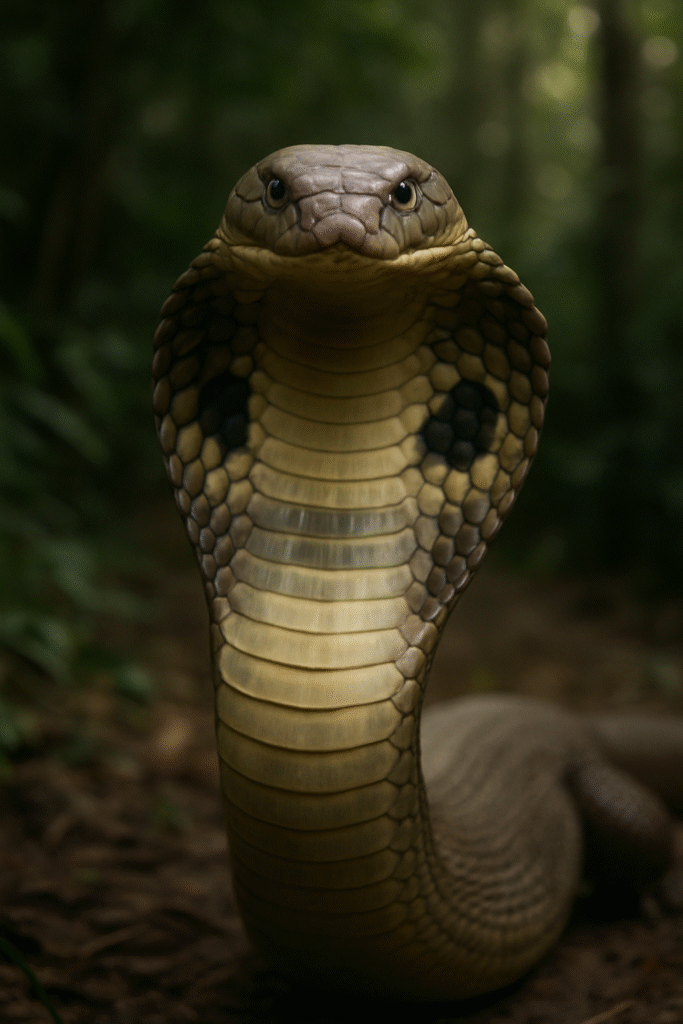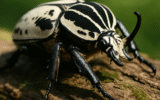In the dense rainforests of South and Southeast Asia, where humidity drapes the air like a second skin, a presence moves with both silence and authority. The King Cobra—Ophiophagus hannah—is not merely a snake. It is a monarch in every sense: feared, revered, and cloaked in mystery. Stretching up to 18 feet, it is the longest venomous snake in the world, a predator so commanding that its very hooded silhouette has become an emblem of both terror and divinity.
The Anatomy of Power
Unlike other serpents, the King Cobra does not hunt indiscriminately. True to its name—Ophiophagus, meaning “snake-eater”—it feeds primarily on other snakes, including venomous species. Its venom is not the most potent in the animal kingdom, but the sheer volume it can deliver in a single strike—enough to kill an elephant—cements its reputation.

What makes the King Cobra truly extraordinary is not only its size or venom, but its intelligence. It has been observed to recognize threats, stand its ground, and even alter its behavior depending on circumstance. Unlike most snakes, it constructs nests for its eggs, guarding them fiercely—a rare glimpse of maternal instinct in the reptilian world.
Shadows in Myth and Legend
Few reptiles have occupied the human imagination like the cobra. In Hindu tradition, the King Cobra is intertwined with gods: the serpent Shesha upon whom Vishnu rests, or the hooded Nāga protecting meditating sages. In Thailand and Myanmar, it has long been seen as both guardian and destroyer, a creature whose presence signals power but also demands respect.
Ancient kings wore its likeness as a crown, the flaring hood symbolizing vigilance and eternal authority. To this day, the image of the cobra rising, its hood spread in warning, strikes at something primal—a reminder of humanity’s oldest confrontation with fear.
The Fragile Throne
Yet even this monarch is not invincible. Deforestation has stripped away much of its territory, leaving it vulnerable in fragmented patches of jungle. Encounters with humans often end in violence, as fear drives people to kill cobras on sight. The illegal wildlife trade has also taken its toll, with cobras captured for skins, venom extraction, or exotic pet markets.

Paradoxically, the cobra’s greatest strength—its mythic reputation—has become both shield and curse. In some cultures, reverence has spared it from extinction; in others, fear has marked it for destruction. Today, conservationists work tirelessly to change that narrative, urging communities to see the cobra not as a monster, but as a keystone predator vital to maintaining ecological balance.
The Crown Endures
To watch a King Cobra in the wild is to witness majesty tinged with danger. It does not slither aimlessly; it moves with purpose, with a slow, deliberate grace that suggests it knows the weight of its crown. When it rises, body lifted high, hood flared, eyes fixed—it is not only a reptile defending itself. It is a ruler reminding the forest, and us, that some thrones are carved not from gold, but from survival, patience, and fear.
The King Cobra embodies a paradox of life itself: fragile yet enduring, feared yet revered, venomous yet nurturing. Its reign is not only in the jungle, but in our myths, our art, and our collective memory. And so long as it survives, the crown of venom will remain, glinting in the shadows of the forest.


Reply